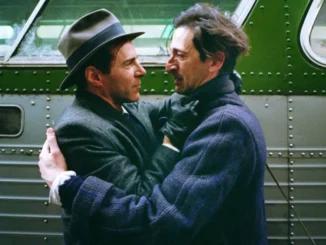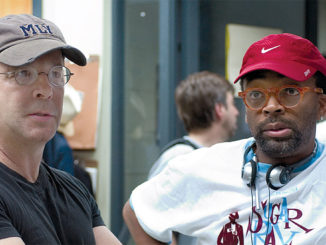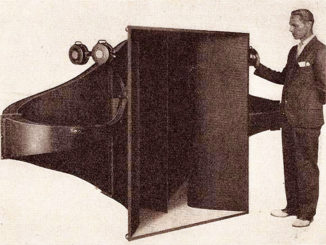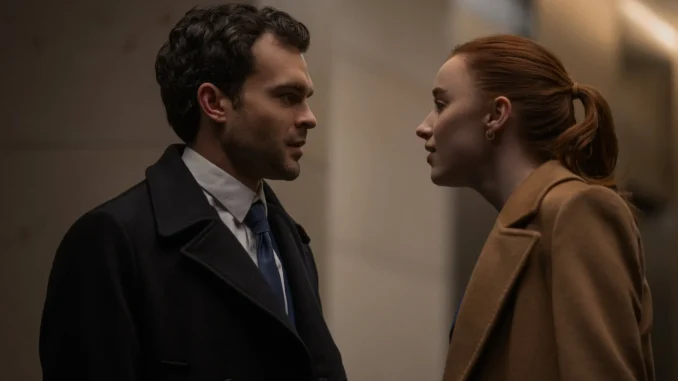
By Peter Tonguette
Imagine the most toxic relationship you can think of.
Imagine a couple who share the same profession — the same place of employment, in fact. Imagine that one half of the couple (he) thinks of himself as being superior, somehow, but when he is proven wrong — when the other half of the couple (she) advances far beyond him thanks to her intelligence and abilities — he comes up with every excuse in the book to account for his failure.
Imagine moments of verbal abuse, brutal power plays, and unheard-of levels of cringe — and you might just have some idea of what the new relationship thriller “Fair Play” is like.
In writer-director Chloe Domont’s film, Alden Ehrenreich stars as Luke and Phoebe Dynevor as Emily, and though they are engaged, their dynamic is profoundly unhealthy: When Emily finds herself tapped for a promotion at the shockingly competitive hedge fund at which she and her fiancé work, Luke is not only sent into a tailspin but lashes out at the woman he claims to care for. Each scene of tension, rage, and resentment is captured in the remarkably piercing and perceptive editing of picture editor Franklin Peterson, whose credits include episodes of “Homecoming,” “Calls,” and “Gaslit.”
The film, which is set to launch on Netflix on Oct. 13, is sure to be among the fall movie season’s most conversation-worthy releases. In that spirit, CineMontage recently had a conversation with editor Peterson and writer-director Domont.
CineMontage: Franklin, what interested you in editing “Fair Play”?
Franklin Peterson: For me, this script really popped off the page. This is one of those things where you read it and it just works in a number of ways. You could see the bones of something that could be unreal or could be bigger than life. You could go several different ways with it. In talking with Chloe, I really got the sense that she had such a clear vision of what she wanted, and that we were all going to be able to help bring this to life. While I like to collaborate, and I’m glad we did find some wonderful magic within the cuts, having that person there who really understands her own material, and can help guide us all toward the goal that we’re aiming for, is just a really great spot to be in.
CineMontage: Chloe, what stood out about Franklin to you?
Chloe Domont: I really liked his work. He had a big background in the thriller genre, so that was important to me. I ultimately consider my film a thriller about power dynamics, so I wanted someone who had the experience in that genre and building up the tension in certain ways. In his work on “Homecoming,” I could sense certain instincts that he had for timing of cuts.
CineMontage: Although it’s set in New York, the picture was shot in Serbia for the most part, right?
Peterson: They only had two days in New York with the principal actors. Everything else was all done on soundstages and on location in Serbia. It’s to their credit that they were able to make it work, and also to Chloe’s credit that, when she did have the time in New York, she maximized it. . . . I was cutting here in L.A., and we communicated through email and calls and Zooms and all that. I sent her scenes back and forth, and we had those conversations.
CineMontage: Initially, how did you both work together?
Peterson: There was a lab processing material in Serbia that sent everything over. We were getting material about a day-and-a-half to two days afterwards, and I was doing the first pass on it. I was making sure we were feeling good about focus. They were [shooting] anamorphic, which you’ve got to be careful about, especially with some of the moving camerawork that she had in there.
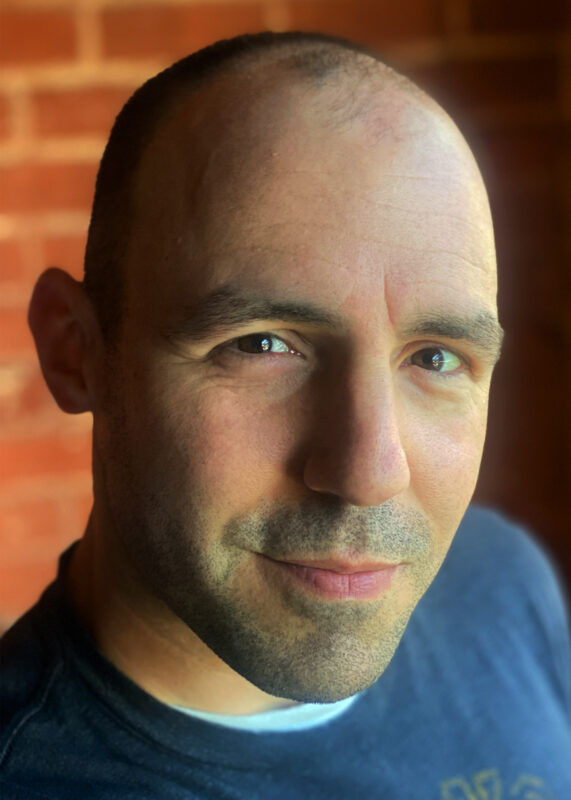
Domont: The editor’s cut is his version of what he thinks is the strongest delivery, and then there’s the version that I’ve always had in my head. If I were to edit this myself, I think it would be a nightmare. I think that would be the worst thing I could ever do. You need those fresh eyes. When I saw the first cut for the first time, he tried certain things that I had never thought about that I thought were great, and then there were other things where I was like, “No, I feel very strongly about sticking to this and this was always the intention.”
Peterson: You want the director to be able to see the cut in its entirety if possible. That’s the way they can really experience what they’ve done, and to make sure that I’m not totally off-base.
CineMontage: Back in L.A., what was the process like when you two sat down together to work?
Peterson: We had a very robust editing timeframe. They wrapped in February or March of 2022, and then we basically didn’t finish the movie until close to September or October, which, for an indie, is very rare.
Domont: You start with the bigger picture stuff, like, “Does the movie work?” That’s the most important thing. Does the story work? We started more global and started more macro, and then as I felt confident and he felt confident, too, that we had a movie, then we could get more micro with it. We just started attacking scene by scene.
Peterson: I set up my timeline in certain ways so that I can be as quick as I can possibly be. Her big thing, which I had not experienced [before], was it was a lot of watching two versions back to back: watching this version, watching that version. That came after we had gone through these very fine-detail passes, and now we were really playing with the direction of each of these scenes in ways that were really going to shift how the movie goes. There was one time when we were really close to the end, and she said, “Remember two months ago when we tried that version with this scene? Can you bring that back up?”
Domont: I never wanted to be too cutty with it. That’s also the way we designed the shots. There were a lot of scenes that I wanted to live in one shot, where it’s just slowly pushing in on Luke or slowly pushing in on Emily, or slowly coming around them and then racking to the other one. It was all from design and the visual directions. I wanted to stay true to that in the edit.
Peterson: We got in there, and Chloe said, “You know, your music choices — I’m not a big fan of melody.” I said, “Melody? Like music?” She said, “You know, I’m more of a tone kind of person.” . . . Chinatown is known for elevated trains, and she shot the elevated trains. We started incorporating that [sound] into some of the scenes and keeping that as a kind of undercurrent. This rumble sound also became an element, and we started to play with this low bass kind of pressure — sometimes it was a subwoofer rumble, sometimes it was more of an underwater rumble. It would shift and change. We deep-dove into this: How much is too much, and how much is too much pressure on the audience?
Domont: I feel like scores made of melody are emotionally leading you. I don’t like to be manipulated that way. I like to be manipulated in other ways, but not with sentiment, if that makes sense. For me, the movie is a pressure cooker, it’s this ballooning tension, I wanted the score [by Brian McOmber] to reflect that. It was very important to me that we didn’t hear any notes that resolved.
CineMontage: Talk about the tone you were trying to achieve in “Fair Play.”
Peterson: I really thought from the get-go that the smart way to play this was to start it off like a straight drama. You sell the characters as if they are a couple you are going to just really root for, and then you pull the rug out slowly from underneath them to the point where, by the time everything starts to go haywire, you’re kind of like, “This is not the movie that you were set up to experience.” Chloe said, “No, I don’t want to do that. I want, from the very first shot, to keep you unsettled.”
Domont: Even talking to Menno [Mans], my DP, we were constantly reminding each other, “Pressure cooker, pressure cooker.” We wanted to build up this ballooning tension — this balloon that just keeps getting bigger and bigger, and you know it’s going to burst at some point, you just don’t know what or when. The idea was building up this tension of this couple who can’t escape each other, really.
Peterson: As we’re all watching this, each of us is seeing it through our own relationship lens. Those that have been in those toxic relationships know what’s coming next, and those that haven’t are perplexed but then realize, “Oh, this is what’s happening.”
Domont: For us, it was trying to build up that tension the right way, so at a certain point, it just becomes excruciating and there’s no other place for it to go but become a dog fight, basically.
Peterson: Each time we would work on things, it would always be: “OK, are we letting our foot off the gas for the audience? Is it relaxing too much for them?”
CineMontage: There are so many moments where Luke’s behavior is cringe-worthy, such as when he gives Emily advice about her appearance.
Peterson: Each person will have their own version of where they find their cringiest moment. . . . How the cringiest stuff hits for each person comes from your own experience, but when it’s working as it should, it has this sense of it keeps building. As much as you could hope that, “Oh, maybe [Luke] figure it out,” he takes that one extra step too far and you go, “Oh, my God.”
‘Each person will have their own version of where they find the cringiest moment.’
Domont: What was really fascinating about this movie — and this was really interesting in the edit process — was that if you dialed one scene a little bit more towards Luke, it completely changes your level of empathy towards Emily for the next 20, 30 minutes in the movie. If you dial it a little bit more towards her, it completely changes how you think about him for the next 30 minutes of the film. I’m talking about small little dials here. I’ve never experienced anything like that, where that subtle of a change with a look or a comment can just completely affect your level of empathy with a character.
Peterson: We were working on the edit and on Luke’s character and the performance and really trying to shape it, and it really came to a place where I said, “Oh, Luke is a man who can never accept that any woman could be better than him.” Even the woman he wants to spend the rest of his life with, even the woman whom he has seen be brilliant and [with] all of her accolades, he can’t conceive of a world in which she could be better than him, and the only answer that he has for why he would be better has to be all of the excuses he comes up with.
CineMontage: We spend a lot of time in Luke’s headspace. How did you perceive the character of Emily?
Peterson: One of the early scenes that I got between [Emily and Luke] is when she comes back from the late-night meeting with the boss, Campbell [Eddie Marsan], when he offers her the job. We had a version of that scene in which Campbell openly offers her the job and says it to her straight-faced. We’re there watching her take this job offer in, and he exits the bar and she’s left to ponder. Then we follow her into the apartment to tell Luke. It worked wonderfully [but] we were doing some test screenings, and people were saying, “You know, what if we don’t hear him offer her the job in the bar, and the first time we, the audience, hear that offer is in the apartment with Luke?” . . . That scene now gets added importance to it. When I first cut that scene, that scene was confusing to me. She almost acts as if there’s been a death, or she acts as if she’s done something really wrong.
Domont: When [Luke’s] moving towards [Emily], after she tells him that she’s just been promoted, he doesn’t know what his reaction is going to be and if the congratulations is genuine or not. I wanted to build the tension, so we put in these floor creaks. It was such a horror trope, but I loved it because it’s so quiet in the apartment and he comes towards her and you just hear the floor creaking.
Peterson: [Emily] knows that [Luke] is this person that she has to be very delicate with. I needed my own time to sort of sit with the material and really gather and understand: “Oh, she’s not only dealing with being a woman in a male-dominated profession, in which she has to be one of the boys but not be too sexy but . . . then, on top of it, she goes home [to] her significant other, who is even more volatile, in a weird way, than [those in] her work environment.”
CineMontage: Were test screenings helpful?
Peterson: Wildly helpful. . . . It’s an R-rated movie for people who want to see an R-rated movie about a toxic relationship, or are willing to go on this ride with us. Once you enter that realm, you’re now asking, “How do we make this the best version of that movie for that group of people?” Ideally, along the way, you’re going to find that more people than we thought are going to be into it, and that would be fantastic. But as long as you make sure the folks that are wanting to watch what you’re delivering are happy, that’s a big part of what this process is.
Domont: Everyone is going to feel differently about the characters in any specific moment of the film, based on who they are, their own experiences, their own biases. We did a lot of test screenings during the director’s cut because I wanted to gauge, where I empathize with Luke, maybe other women didn’t of certain ages, or certain men. We started to start to feel where people were leaning, and towards the later screenings, it felt like the intention that I wanted was coming through in the audience.



